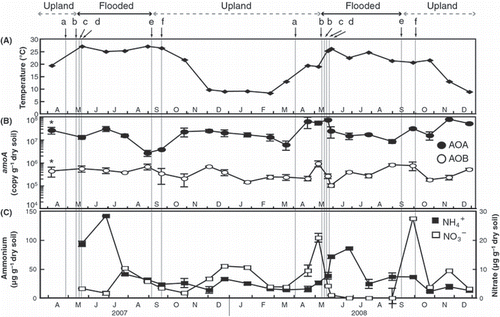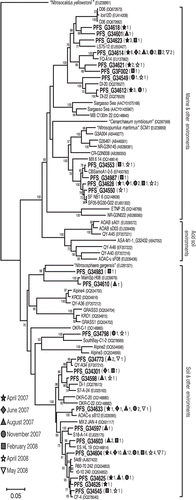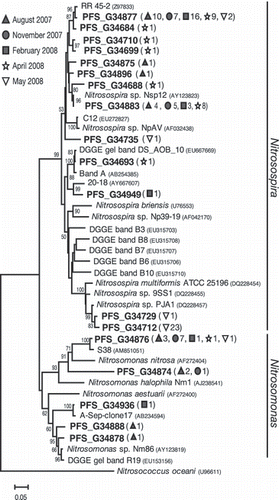Figures & data
Figure 1 Successions in (A) soil temperature, (B) abundance of crenarchaeotal and betaproteobacterial amoA genes (n = 3) in soil and (C) NO3− and NH4+ concentrations (n = 3) in soil. a, plowing; b, basal fertilization and flooding; c, puddling; d, transplanting; e, drainage; f, rice harvesting. Error bars are standard deviations (n = 3). Asterisks above the symbols from April 2007 indicate that the values were estimated as wet weight soil.

Figure 2 Phylogenetic tree based on crenarchaeotal amoA gene sequences (579 bp) determined by neighbor-joining analysis. Boldface type indicates representative amoA clones obtained in the present study. Numbers and symbols in parentheses denote the total number of clones detected from soils on 7 April, 6 June, 28 August, 28 November 2007, and 27 February, 23 April and 9 May 2008. The scale bar represents an estimated sequence divergence of 5%. Numbers at the nodes indicate the bootstrap values (≥50%).

Table 1 Frequency changes in ammonia-oxidizing archaea and ammonia-oxidizing bacteria clone libraries obtained from bulk paddy field soil
Figure 3 Phylogenetic tree based on betaproteobacterial amoA gene sequences (450 bp) determined by neighbor-joining analysis. Boldface type indicates representative amoA clones obtained in the present study. Numbers and symbols in parentheses denote the total number of clones detected from soils on 28 August, 28 November 2007, and 27 February, 23 April and 9 May 2008. The scale bar represents an estimated sequence divergence of 5%. Numbers at the nodes indicate the bootstrap values (≥50%).
